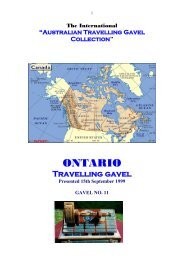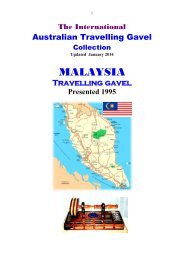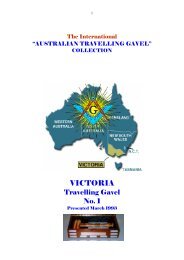TAMWORTH
Read more - Travelling Gavels
Read more - Travelling Gavels
- No tags were found...
You also want an ePaper? Increase the reach of your titles
YUMPU automatically turns print PDFs into web optimized ePapers that Google loves.
152<br />
Best wishes for your ongoing search, yours fraternally<br />
RWB Roger Ottaway PSGW<br />
Information about Namur Belgium:<br />
Namur is a city and municipality in Wallonia, in southern Belgium. It is both the capital of<br />
the province of Namur and (since 1986) of Wallonia.<br />
Namur stands at the confluence of the Sambre and Meuse rivers and straddles three different regions – Hesbaye<br />
to the north, Condroz to the south-east and Entre-Sambre-et-Meuse to the south-west. The language spoken<br />
is French.<br />
The City of Namur includes the old communes of Beez, Belgrade, Saint-Servais, Saint-Marc, Bouge, Champion,<br />
Daussoulx, Flawinne, Malonne, Suarlée, Temploux, Vedrin, Boninne, Cognelée, Gelbressée, Marche-les-<br />
Dames, Dave, Jambes, Naninne,Wépion, Wierde, Erpent, Lives-sur-Meuse, and Loyers.<br />
The town began as an important trading settlement in Celtic times, straddling east-west and north-south trade<br />
routes across the Ardennes. The Romans established a presence after Julius Caesar defeated the<br />
local Aduatuci tribe.<br />
Namur came to prominence during the early middle ages when the Merovingians built a castle or citadel on the<br />
rocky spur overlooking the town at the confluence of the two rivers. In the 10 th century it became a county in its<br />
own right. The town developed somewhat unevenly, as the counts of Namur could only build on the north bank<br />
of the Meuse – the south bank was owned by the bishops of Liège and developed more slowly into the town of<br />
Jambes (now effectively a suburb of Namur). In 1262, Namur fell into the hands of the Count, and was<br />
purchased by Duke Philip the Good of Burgundy in 1421.<br />
After Namur became part of the Spanish Netherlands in the 1640s, its citadel was considerably<br />
strengthened. Louis XIV of France invaded in 1692, capturing the town and annexing it to France. His<br />
renowned military engineer Vauban rebuilt the citadel. French control was short-lived, as William III of Orange-<br />
Nassau captured Namur only three years later in 1695 during the War of the Grand Alliance. Under the Barrier<br />
Treaty of 1709, the Dutch gained the right to garrison Namur, although the subsequent Treaty of Utrecht of<br />
1713 gave control of the formerly Spanish Netherlands to<br />
the Austrian House of Habsburg. Thus, although the<br />
Austrians ruled the town, the citadel was controlled by the<br />
Dutch. It was rebuilt again under their tenure.<br />
France invaded the region again in 1794, during the French<br />
Revolutionary Wars, and again annexed Namur, imposing a<br />
repressive regime. After the defeat of Napoleon in 1815,<br />
the Congress incorporated what is now Belgium into<br />
the United Kingdom of the Netherlands. Belgium broke<br />
away from the Netherlands in 1830 following the Belgian<br />
Revolution, and Namur continued to be a major garrison<br />
town under the new government. The citadel was rebuilt<br />
yet again in 1887.<br />
Namur was a major target of the German invasion of Belgium in 1914, which sought to use the Meuse valley as<br />
a route into France. Despite being billed as virtually impregnable, the citadel fell after only three days’ fighting<br />
and the town was occupied by the Germans for the rest of the war. Namur fared little better in World War II; it<br />
was in the front lines of both the Battle of the Ardennes in 1940 and the Battle of the Bulge in 1944. The town<br />
suffered heavy damage in both wars.<br />
Namur continued to host the Belgian Army’s paratroopers until their departure in 1977.<br />
Economy:<br />
Namur is an important commercial and industrial centre, located on the Walloon industrial backbone,<br />
the Sambre and Meuse valley. It produces machinery, leather goods, metals and porcelain It is also an important







